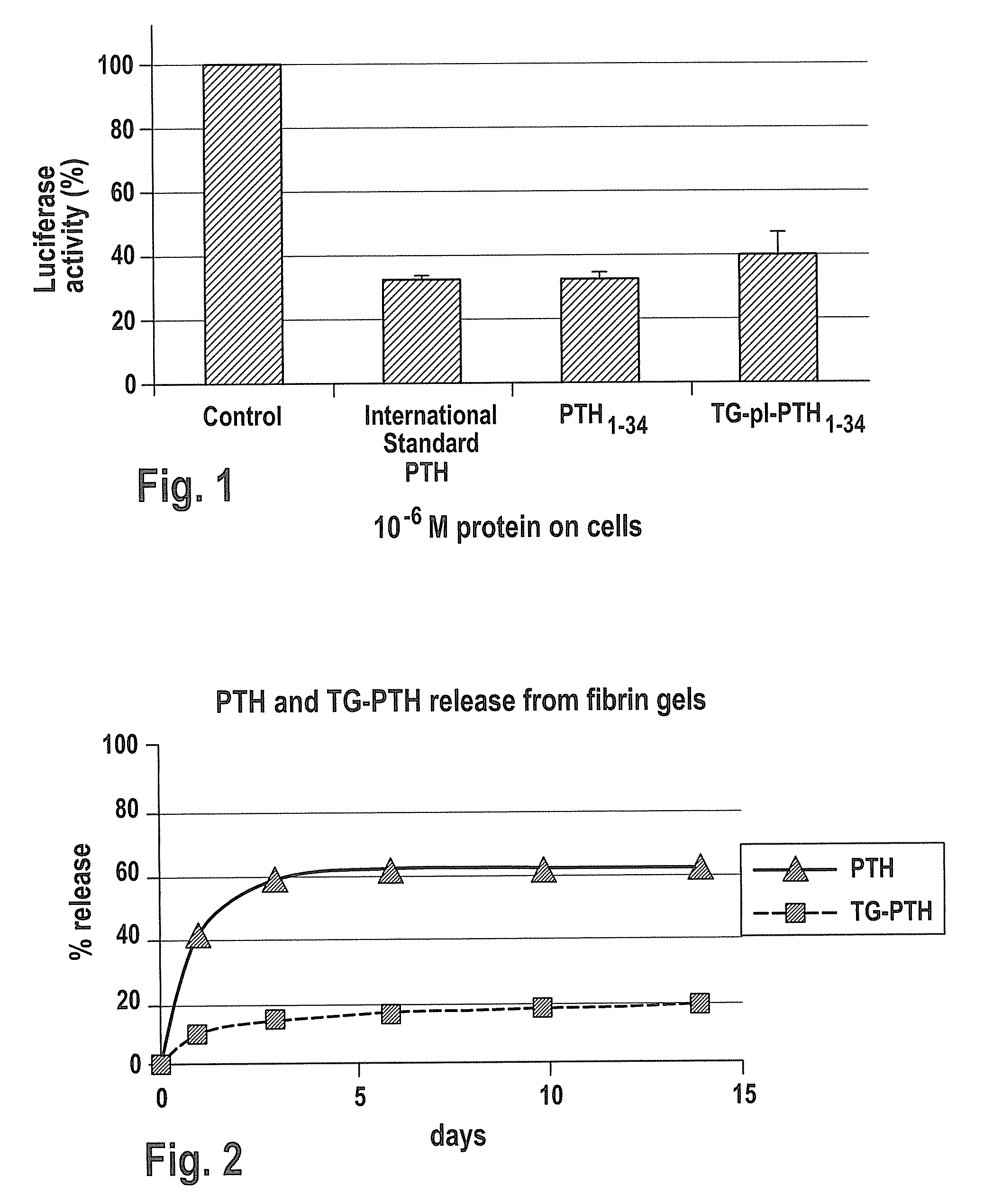Local treatment of bone defects
a local treatment and bone cyst technology, applied in the field of local treatment of bone cysts, can solve the problems of reducing the overall strength of the bone, prone to fracture, and increasing the rate of bone loss
- Summary
- Abstract
- Description
- Claims
- Application Information
AI Technical Summary
Benefits of technology
Problems solved by technology
Method used
Image
Examples
example 1
Bioactivity of PTH1-34 and TGplPTH1-34
[0147] PTH1-34-peptide showing similar activity to the full length PTH1-84, and proteins of this length can be synthesized by standard solid state peptide synthesis methods.
[0148] All peptides were synthesized on solid resin using an automated peptide synthesizer using standard 9-fluorenylmethyloxycarbonyl chemistry. Peptides were purified by c18 chromatography and analyzed using reverse phase chromatography via HPLC to determine purity as well as mass spectroscopy (MALDI) to identify the molecular weight of each product. Using this method, PTH1-34 as well as, TG-pl-PTH1-34 (NQEQVSPLYKNRSVSEIQLMHNLGKHLNSMERVEWLRKKLQDVHNF (SEQ ID NO: 20)) and TGPTH1-34 (NQEQVSPLSVSEIQLMHNLGKHLNSMERVEWLRKKLQDVHNF (SEQ ID NO: 21)) were synthesized. TGplPTH1-34 and TGPTH1-34 differs from PTH1-34 in that it additionally comprises the Factor XIIIa substrate domain which is linked to PTH1-34 via the plasmin degradable pl-sequence YKNR (SEQ ID NO: 19) in case of TGplP...
example 2
PTH Release from a Fibrin Matrix
[0150] A fibrin matrix was made from TISSEEL® Kit (Baxter AG, CH-8604 Volketswil / ZH) fibrin precursor components. The composition is listed in Table 2. In the presence of 0.1 μg / ml of PTH1-34 or TGPTH1-34 was then added to the thrombin, and mixed to form a homogenous concentration. TGPTH1-34 only has a transglutaminase sequence at the amino terminus, without a degradation site. Thus, TGPTH1-34 can only be liberated by degradation of the fibrin matrix itself. This peptide was synthesized as described above in Example 1.
[0151] For the first release assay, a fibrin matrix of 50 μl with 0.1 mg PTH or TGPTH per ml fibrin matrix was incubated at 37° C. in 10 ml buffer. Therefore, the concentration of PTH or TGPTH in the buffer in case of a total release would be 0.5 μg PTH or TGPTH / mL fibrin matrix. In order to compare the stability of PTH or TGPTH during the assay, samples of PTH or TGPTH were diluted directly in the buffer to a concentration of 0.5 μg P...
example 3
Synthesis of a Supplemented Fibrin Matrix Comprising a PTH Fusion Peptide
[0155] The fibrin matrix was formed starting from the TISSEEL® Kit (Baxter AG, CH-8604 Volketswil / ZH) giving 4 mL fibrin matrix. TISSEEL® was produced from human derived pooled plasma and the content of active ingredients may vary from lot to lot within predefined ranges. Table 2 lists the final composition used.
TABLE 2Final Composition comprising TISSEEL ® and active componentIngredientsDose per 2 mL gelSyringe 1 (1 mL)Active Component:0.2 to 20mgPTH1-34 fusion peptide (TGplPTH1-34)Clotting AgentsFibrinogen (Human)66-100mgOther ProteinsAprotinin (Bovine)2046-3409KIUHuman Albumin9.1-18.2mgBuffer ComponentsNiacinamide2.7-8.2mgL-Histidine9.1-22.7mgSodium Citrate4.4-8.8mgPolysorbate 800.6-1.7mgWater for Injectionto 1mLSyringe 2 (1 mL)Clotting AgentsThrombin (Human)2.5-6.5I.U.Buffer ComponentsCalcium Chloride5.88 ± 0.6mgSodium Chloride3.5-5.5mgHuman Serum Albumin45-55mgWater for Injectionto 1mL
[0156] Fibrinogen ...
PUM
| Property | Measurement | Unit |
|---|---|---|
| Density | aaaaa | aaaaa |
| Density | aaaaa | aaaaa |
| Density | aaaaa | aaaaa |
Abstract
Description
Claims
Application Information
 Login to View More
Login to View More - R&D
- Intellectual Property
- Life Sciences
- Materials
- Tech Scout
- Unparalleled Data Quality
- Higher Quality Content
- 60% Fewer Hallucinations
Browse by: Latest US Patents, China's latest patents, Technical Efficacy Thesaurus, Application Domain, Technology Topic, Popular Technical Reports.
© 2025 PatSnap. All rights reserved.Legal|Privacy policy|Modern Slavery Act Transparency Statement|Sitemap|About US| Contact US: help@patsnap.com

